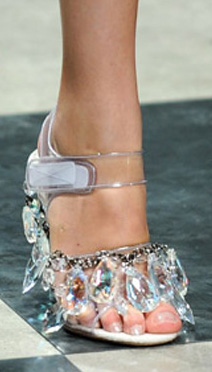Some Designers Say Their Work Deserves Copyright Protection; Others Say It Would Harm the Industry

Prada’s acrylic-heel “stripper shoe” concept was continued in its 2010 collection shown a Women’s Fashion Week in Milan. Photo by Giusseppe Cacace/AFP/Getty Images.
It was the fall of 2003 when Giacomo Corrado purchased his very first pair of “stripper shoes.” Strolling in the Soho neighborhood of New York City, Corrado spotted a divine pair of Prada pumps and just had to have them.
But Corrado wasn’t stocking his personal shoe collection; he was scouting the latest style trends for the Italian fashion house Fornarina, where he worked at the time as the company’s American chief executive officer.
“Prada had done it again,” Corrado recalls. The shoes “were daring, sexy, absolutely innovative—a new trend—yet they reconciled with the most exquisite elegance: a blue patent leather sandal, ornate with gold edges, over the platform frame of the stripper’s shoe.”
Ladies who lunch met ladies of the pole in the ubiquitous sandals that were marketed in upscale stores across the country as the fashion du jour. But the design was hardly original. Exotic dancers in strip clubs from Las Vegas to Panama City, Fla., had been sporting the style for years and for hundreds of dollars less. But with the creative twist and imprimatur of one of the fashion world’s most celebrated labels, the stripper shoe turned into something else.
“The trend became ‘fashion,’ ” explains Corrado, an attorney now in private practice in New York City and an instructor at both the Fashion Institute of Technology and New York University’s School of Continuing and Professional Studies. “It inspired and guided nearly every shoe designer in the world, filling the shoe floor of every department store and boutique.”
Corrado says the popular trend wouldn’t have been able to spread if the original concept had been subject to the Innovative Design Protection and Piracy Prevention Act, a bill pending before Congress that for the first time would give fashion design copyright protection. Sponsored by Sen. Charles Schumer, D-N.Y., and supported by the Council of Fashion Designers of America, the IDPPPA is close to becoming law. But whether it’s good law or bad law is a matter of heated debate.
Click here to read the rest of “The Genuine Article” from the July issue of the ABA Journal.



